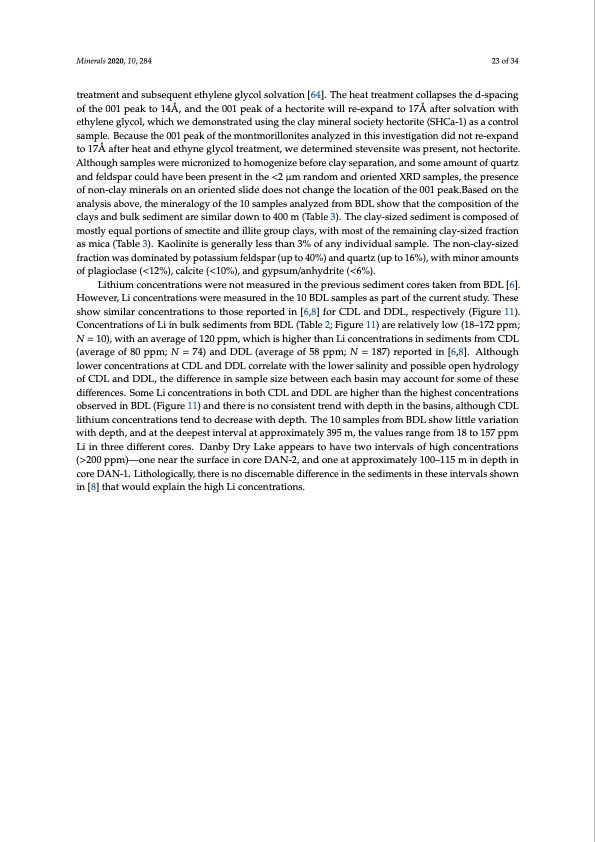
PDF Publication Title:
Text from PDF Page: 023
Minerals 2020, 10, 284 23 of 34 treatment and subsequent ethylene glycol solvation [64]. The heat treatment collapses the d-spacing of the 001 peak to 14Å, and the 001 peak of a hectorite will re-expand to 17Å after solvation with ethylene glycol, which we demonstrated using the clay mineral society hectorite (SHCa-1) as a control sample. Because the 001 peak of the montmorillonites analyzed in this investigation did not re-expand to 17Å after heat and ethyne glycol treatment, we determined stevensite was present, not hectorite. Although samples were micronized to homogenize before clay separation, and some amount of quartz and feldspar could have been present in the <2 μm random and oriented XRD samples, the presence of non-clay minerals on an oriented slide does not change the location of the 001 peak.Based on the analysis above, the mineralogy of the 10 samples analyzed from BDL show that the composition of the clays and bulk sediment are similar down to 400 m (Table 3). The clay-sized sediment is composed of mostly equal portions of smectite and illite group clays, with most of the remaining clay-sized fraction as mica (Table 3). Kaolinite is generally less than 3% of any individual sample. The non-clay-sized fraction was dominated by potassium feldspar (up to 40%) and quartz (up to 16%), with minor amounts of plagioclase (<12%), calcite (<10%), and gypsum/anhydrite (<6%). Lithium concentrations were not measured in the previous sediment cores taken from BDL [6]. However, Li concentrations were measured in the 10 BDL samples as part of the current study. These show similar concentrations to those reported in [6,8] for CDL and DDL, respectively (Figure 11). Concentrations of Li in bulk sediments from BDL (Table 2; Figure 11) are relatively low (18–172 ppm; N = 10), with an average of 120 ppm, which is higher than Li concentrations in sediments from CDL (average of 80 ppm; N = 74) and DDL (average of 58 ppm; N = 187) reported in [6,8]. Although lower concentrations at CDL and DDL correlate with the lower salinity and possible open hydrology of CDL and DDL, the difference in sample size between each basin may account for some of these differences. Some Li concentrations in both CDL and DDL are higher than the highest concentrations observed in BDL (Figure 11) and there is no consistent trend with depth in the basins, although CDL lithium concentrations tend to decrease with depth. The 10 samples from BDL show little variation with depth, and at the deepest interval at approximately 395 m, the values range from 18 to 157 ppm Li in three different cores. Danby Dry Lake appears to have two intervals of high concentrations (>200 ppm)—one near the surface in core DAN-2, and one at approximately 100–115 m in depth in core DAN-1. Lithologically, there is no discernable difference in the sediments in these intervals shown in [8] that would explain the high Li concentrations.PDF Image | Bristol Dry Lake Brine Compared to Brines from Cadiz

PDF Search Title:
Bristol Dry Lake Brine Compared to Brines from CadizOriginal File Name Searched:
minerals-10-00284-v2.pdfDIY PDF Search: Google It | Yahoo | Bing
Product and Development Focus for Infinity Turbine
ORC Waste Heat Turbine and ORC System Build Plans: All turbine plans are $10,000 each. This allows you to build a system and then consider licensing for production after you have completed and tested a unit.Redox Flow Battery Technology: With the advent of the new USA tax credits for producing and selling batteries ($35/kW) we are focussing on a simple flow battery using shipping containers as the modular electrolyte storage units with tax credits up to $140,000 per system. Our main focus is on the salt battery. This battery can be used for both thermal and electrical storage applications. We call it the Cogeneration Battery or Cogen Battery. One project is converting salt (brine) based water conditioners to simultaneously produce power. In addition, there are many opportunities to extract Lithium from brine (salt lakes, groundwater, and producer water).Salt water or brine are huge sources for lithium. Most of the worlds lithium is acquired from a brine source. It's even in seawater in a low concentration. Brine is also a byproduct of huge powerplants, which can now use that as an electrolyte and a huge flow battery (which allows storage at the source).We welcome any business and equipment inquiries, as well as licensing our turbines for manufacturing.| CONTACT TEL: 608-238-6001 Email: greg@infinityturbine.com | RSS | AMP |